en
names in breadcrumbs


Microhyla rubra, the red narrow-mouthed frog, is a small stout microhylid frog with fossorial habits.Thurston (1888) and Boulenger (1890) originally described it from lowland peninsular India and Sri Lanka, but more recent work indicates that the population in Sri Lanka is in fact a distinct species, M. mihintalei, based on call, morphology, and genetics (Wijayathilaka 2016).The range of M. rubra has been extended since to Bangladesh and western Myanmar (Wogan et al. 2008). An abundant species, it inhabits dry areas including forests, brushlands and agricultural lands.By day adults burrow under soil, leaves, in rubble piles and other ground cover, including elephant dung (Campos‐Arceiz 2009).It is able to withstand disturbance, and is found living close to humans and urbanized environments. The cryptic, nocturnal and burrowing nature of M. rubra contributes to its poorly known biology, ecology and distribution, despite the fact that it is abundant and wide-spread near human habitation Bowatte and Meegaskumbura (2011).
A smooth-skinned frog, M. rubra has a reddish dorsal surface, and darker sides.A dark stripe runs from its rounded snout through its eyes and back to its hind legs. Its legs have a banded pattern, and there is a dark brown mark across the thigh.Its belly is creamy white, sometimes with brown markings on the throat. Male snout-vent length is 20-28 mm, females are slightly larger at 20-30 mm (Thurston 1888; Boulenger 1890)
Microhyla rubra reproduces in still ephemeral pools and rice paddies.Adults breed during monsoon season, producing flat, transparent egg masses. Bowatte and Meegaskumbura (2011) characterized the larval stages of “Microhyla rubra” in Sri Lanka. As stated above, Sri Lankan populations are now considered to be a new, closely related species, M. mihintalei.It would be interesting to compare the biology of tadpoles from peninsular India.Sri Lankan tadpoles swim close to the water surface, feeding on plankton and suspended particles.They develop in 77 days. Bowatte and Meegaskumbura (2011) found that in Sri Lanka these tadpoles were not found in any rice paddies, only in ephemeral pools.
Microhyla rubra is also known as the Guangdong rice frog and Jerdon’s narrow-mouthed frog (Frost 2016).